Here’s Why Thor Did What He Did at the End of Infinity War

*** AHOY MATEY, INFINITY WAR SPOILERS BE AHEAD ***
The God of Thunder is a new favorite for many Marvel fans due to his heroics in Avengers: Infinity War, but some have questioned Thor’s aim.
Thor has one of the biggest character arcs in Infinity War. The movie opens with Thanos’ brutal attack on his Asgardian refugee ship, and in one fell swoop, Thor loses half his people, his best friend Heimdall, and his (mostly) reformed brother Loki. Thor has had a terrible, horrible, no-good, very bad day.
The rest of his storyline is a tragedy-driven quest for Thor to find a weapon powerful enough to deliver his promised revenge unto Thanos, or die trying. With Stormbreaker the axe in hand at last, he has a spectacular entrance into Wakanda with Rocket and Groot, turning the tide on the Outrider battle.
But when he finally comes face to face with Thanos again, Thor lodges the axe in Thanos’ chest and not, as the Titan points out, in the head, as he should have. Because of this, Thanos still has time to complete The Snapture and thus render half the universe’s population into dust. Thor, who’s been fighting foul beasties for 1500 years, surely knew the most effective killing blow for someone as dangerous as Thanos. So what gives?
According to director Joe Russo, Thor was fueled by emotion in this moment rather than strategy. Russo spoke with Comicbook.com about why one of the most experienced warriors in the universe made such a rookie mistake:
“I would argue that the fan base could be equally upset with Thor [as they are with Star-Lord], who chose to throw that ax into Thanos’ chest and not his head,” Joe Russo tells ComicBook.com. “Because he wanted to tell Thanos that he got his revenge.”
While many people and articles have piled on Star-Lord for losing control over Gamora’s death and messing up the plan to stop Thanos on Titan, arguably you could say that Thor was guided by a similar principle. Still raging and in mourning, he wanted Thanos to know exactly who was taking him down.
It may not have been the logical choice, but we can certainly understand why Thor did it. Of all the Avengers and their allies, Thor had lost the most because of Thanos’ plans, and both Thor and Peter Quill lost the people that they love dearly. At this moment, though he is a god with incredible powers and more than a thousand years under his belt, Thor’s reaction was very human.
According to Russo, it’s important to let characters make mistakes when they are suffering, even superheroes. Especially superheroes. No one can be perfect on all fronts, and thinking about why people make choices that we do not understand or agree with can help expand our sense of empathy.
“Had [Thor] gone for a kill shot, that snap would not have happened. These are choices that characters who are feeling immense pain make and hopefully, the audience can learn to empathize with those characters because they can grow through stories,” Joe Russo went on. “Stories can teach us things and that we should try to see every choice from the perspective of the character that made the choice.”
While I have my issues with Infinity War—especially that opening scene (let Loki live, dammit)—I love this sentiment from Russo and his emphasis on how much stories can change and shape the world through teachable moments.
But remember, kids: the lesson from Infinity War is that when facing down a mad purple Titan with your awesome Groot-handled mega-axe, think with your head and not your heart.
(via Comicbook.com, image: Marvel Studios)
Want more stories like this? Become a subscriber and support the site!
—The Mary Sue has a strict comment policy that forbids, but is not limited to, personal insults toward anyone, hate speech, and trolling.—
Have a tip we should know? tips@themarysue.com